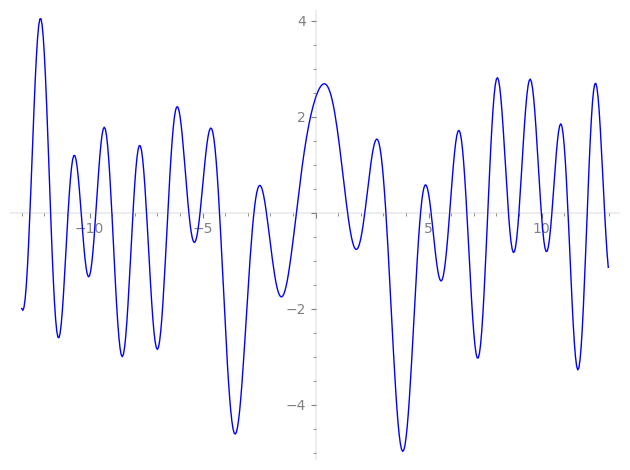| L(s) = 1 | + 3·5-s + (2.5 − 0.866i)7-s − 3·11-s + (−1 − 1.73i)13-s + (−1.5 − 2.59i)17-s + (0.5 − 0.866i)19-s + 3·23-s + 4·25-s + (3 − 5.19i)29-s + (3.5 − 6.06i)31-s + (7.5 − 2.59i)35-s + (0.5 − 0.866i)37-s + (−3 − 5.19i)41-s + (2 − 3.46i)43-s + (4.5 + 7.79i)47-s + ⋯ |
| L(s) = 1 | + 1.34·5-s + (0.944 − 0.327i)7-s − 0.904·11-s + (−0.277 − 0.480i)13-s + (−0.363 − 0.630i)17-s + (0.114 − 0.198i)19-s + 0.625·23-s + 0.800·25-s + (0.557 − 0.964i)29-s + (0.628 − 1.08i)31-s + (1.26 − 0.439i)35-s + (0.0821 − 0.142i)37-s + (−0.468 − 0.811i)41-s + (0.304 − 0.528i)43-s + (0.656 + 1.13i)47-s + ⋯ |
\[\begin{aligned}\Lambda(s)=\mathstrut & 2268 ^{s/2} \, \Gamma_{\C}(s) \, L(s)\cr =\mathstrut & (0.678 + 0.734i)\, \overline{\Lambda}(2-s) \end{aligned}\]
\[\begin{aligned}\Lambda(s)=\mathstrut & 2268 ^{s/2} \, \Gamma_{\C}(s+1/2) \, L(s)\cr =\mathstrut & (0.678 + 0.734i)\, \overline{\Lambda}(1-s) \end{aligned}\]
Particular Values
| \(L(1)\) |
\(\approx\) |
\(2.394052064\) |
| \(L(\frac12)\) |
\(\approx\) |
\(2.394052064\) |
| \(L(\frac{3}{2})\) |
|
not available |
| \(L(1)\) |
|
not available |
\(L(s) = \displaystyle \prod_{p} F_p(p^{-s})^{-1} \)
| $p$ | $F_p(T)$ |
|---|
| bad | 2 | \( 1 \) |
| 3 | \( 1 \) |
| 7 | \( 1 + (-2.5 + 0.866i)T \) |
| good | 5 | \( 1 - 3T + 5T^{2} \) |
| 11 | \( 1 + 3T + 11T^{2} \) |
| 13 | \( 1 + (1 + 1.73i)T + (-6.5 + 11.2i)T^{2} \) |
| 17 | \( 1 + (1.5 + 2.59i)T + (-8.5 + 14.7i)T^{2} \) |
| 19 | \( 1 + (-0.5 + 0.866i)T + (-9.5 - 16.4i)T^{2} \) |
| 23 | \( 1 - 3T + 23T^{2} \) |
| 29 | \( 1 + (-3 + 5.19i)T + (-14.5 - 25.1i)T^{2} \) |
| 31 | \( 1 + (-3.5 + 6.06i)T + (-15.5 - 26.8i)T^{2} \) |
| 37 | \( 1 + (-0.5 + 0.866i)T + (-18.5 - 32.0i)T^{2} \) |
| 41 | \( 1 + (3 + 5.19i)T + (-20.5 + 35.5i)T^{2} \) |
| 43 | \( 1 + (-2 + 3.46i)T + (-21.5 - 37.2i)T^{2} \) |
| 47 | \( 1 + (-4.5 - 7.79i)T + (-23.5 + 40.7i)T^{2} \) |
| 53 | \( 1 + (1.5 + 2.59i)T + (-26.5 + 45.8i)T^{2} \) |
| 59 | \( 1 + (4.5 - 7.79i)T + (-29.5 - 51.0i)T^{2} \) |
| 61 | \( 1 + (-0.5 - 0.866i)T + (-30.5 + 52.8i)T^{2} \) |
| 67 | \( 1 + (-3.5 + 6.06i)T + (-33.5 - 58.0i)T^{2} \) |
| 71 | \( 1 + 71T^{2} \) |
| 73 | \( 1 + (-0.5 - 0.866i)T + (-36.5 + 63.2i)T^{2} \) |
| 79 | \( 1 + (-6.5 - 11.2i)T + (-39.5 + 68.4i)T^{2} \) |
| 83 | \( 1 + (6 - 10.3i)T + (-41.5 - 71.8i)T^{2} \) |
| 89 | \( 1 + (7.5 - 12.9i)T + (-44.5 - 77.0i)T^{2} \) |
| 97 | \( 1 + (-5 + 8.66i)T + (-48.5 - 84.0i)T^{2} \) |
| show more | |
| show less | |
\(L(s) = \displaystyle\prod_p \ \prod_{j=1}^{2} (1 - \alpha_{j,p}\, p^{-s})^{-1}\)
Imaginary part of the first few zeros on the critical line
−9.012611170970182480653206575889, −8.077640387632472704353197694227, −7.47780898658539831513244281411, −6.53553974454786450805556713423, −5.60583023765135065590844042035, −5.11077792079926952798338981491, −4.24882118858873434484502336128, −2.72661340318358794817875419747, −2.17438803483430949050960317334, −0.848039094006104399924121059848,
1.41619095905830985023074902380, 2.17897767403272087355911664138, 3.11110187879633146575881872589, 4.64623215368187315270055912545, 5.11177778832526010162408683924, 5.93354554291838312613028279328, 6.69287195930079397327095657453, 7.61894333420969501320239071835, 8.532629305506617940502958397242, 8.996709470845629240757928136072

